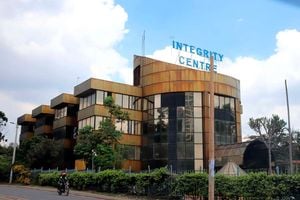Illegal gold mining harms Kakamega’s ecosystem

Makhoya stream in Shinyalu, Kakamega. The stream is said to be facing environmental challenges due to pollution from gold mining. facing the stream.
What you need to know:
- Villages along the banks of River Ikoha are already on the brink of collapse.
- Reports indicate that over 8,000 artisanal miners operate in Kakamega’s gold mines.
Unregulated gold mining in Ikolomani and Shinyalu constituencies in Kakamega County has led to severe environmental degradation. Rivers and streams in the area are shrinking, with water becoming acidic. Gold mining, the primary source of income in the region, is being carried out within rivers, exacerbating erosion and pollution of water.
Villages along the banks of River Ikoha are already on the brink of collapse. The social impact is also massive, with school-going children being lured to the gold trade at the expense of education. Reports indicate that over 8,000 artisanal miners operate in Kakamega’s gold mines.
Residents of Makhaya village in Shitochi sub-location have raised concern over the environmental degradation caused by mining activities within the River Ikoha basin. Due to pollution caused by mining activities, water in the river is no longer safe for use. Furthermore, the river’s edges are collapsing due to erosion.
Mining tailings (materials left behind after the economically valuable fraction of material has been extracted) are causing pollution as they are believed to be toxic and acidic. Tailings consist of substances like mercury, cyanide, and arsenic, which are used for further mineral separations.
Mr Emmanuel Mbakaya, whose land spreads to the edge of River Ikoha, said they have raised concerns but the relevant authorities have not taken any action.
“Gold mining has informally employed thousands of people and won’t end soon. But there should be regulations so that it doesn’t create disasters,” said Mr Mbakaya.
Mukoha bridge, which connects Sigalagala and Ikambi ya Khayega, has been damaged by miners, who dug pits at the bridge as they extended their activities down the stream. “The river we rely on has been polluted. Our efforts to get help from the relevant authorities have hit a brick wall even as the damage escalates,” said Mr Mbakaya.
Mr Godfrey Musoka, another resident, accused the local leadership, including chiefs, of looking the other way as gold mining takes a toll on their environment.
“The low-tech and subsistence mining operations are often unsafe, and the poor management of sites leads to environmental pollution in the region.
A lot of destruction is going on. Gold miners have installed stone crushers that generate industrial-scale noise daily, affecting schools around here, yet no official has raised concern,” complained Mr Musoka. Residents have also sought the help of the National Environment Management Authority (Nema) in vain.
“River Ikoha and other streams within Isukha in Kakamega are being destroyed. We have now been forced to buy water on a daily basis. Please intervene,” read one of the letters by a resident to Nema.
Kakamega County Chief Officer for Environment, Natural Resources and Climate Change Justin Mutobera said they received the complaints from the villagers and sent an officer to conduct investigations. He said that the county government is concerned that illegal mining is still rampant in the area despite the dangers it poses to humans and the environment.
“We are engaging the national government and Nema to conduct a multi-agency survey and assess challenges caused by illegal mining in the area so that we can address the concerns that have been raised. Soon, we shall be moving to the affected sites to contain the activities,” said Mr Mutobera.
According to government data, Kakamega County has at least 1.31 million ounces of gold deposits along the Lirhanda corridor valued at Sh171 billion. The corridor stretches from Shinyalu to Ikolomani, and part of it sits in neighbouring Vihiga County.




